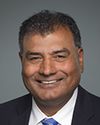Thanks very much for this opportunity.
I'm going to build on some of the comments my colleagues just made.
As a researcher, I'd like to introduce to the committee a frame of reference to make the decisions, which are obviously very complex and have long-term ramifications, as we have just heard.
In my role as a Canada research chair, I lead a national coalition of researchers and service provider organizations. We have contributions from four federal departments as well. We're trying to understand the refugee experience from the child's and the family's points of view.
Let me see if I can ground this for you. Let's think about this. Some of you on this committee have children, I take it. If there were a crisis right now, and you got that very urgent phone call, I wonder whether you would have the social capital to respond.
In a sense, when we begin to think in these terms, that family reunification is fundamentally not just avoiding problems, avoiding some of the stressors on families—that's what I study, stress and resilience and the way people cope across cultures—you also have to ask yourself what resources are being built.
I'm going to argue, and I think the evidence shows this, that you're increasing the chances and the likelihood of social integration by expanding the size of the families that come to Canada, offering ways of streamlining this opportunity for family reunification, as you just heard.
If we can break this down into some simple processes, which is what I study, we need ways of simplifying this question.
Seven things are leveraged by expediting a family reunification process for immigrants or refugees. Relationships are obvious. But it's not just the idea of an intimate attachment. You're giving people the support they need during those crisis times. As we know from the literature, people tend to stay together when the families are reunified.
What about identity? You're helping kids know who they are. We have a crisis sometimes, and we talk about this. We're worried about children losing identity. We're worried about the violence that potentially follows from that. Yet here we have a way of addressing some of these other bigger concerns that are sometimes put together, inadvertently or intentionally, when we talk about immigrants.
What about issues of control? You certainly open up opportunities for families to have more opportunities. A very simple one of course is you give parents a much greater latitude in where they're going to be able to work, the number of hours they can transit to their workplaces, by increasing the family supports, whether that's an aunt, an uncle, an older child, an older sibling, or a grandparent who is present in the home.
We're also talking about fair treatment. You are bringing in people to be advocates for each other, which is of course important.
Needless to say, all the research says that you increase material wealth or resources for the families as well. You increase the income, the potential for money inside a home, which of course translates into someone helping the children learn. More resources in technology or supports are the tipping point for educational gains for children who are in transition and under stress.
You increase a sense of belonging, cultural continuity. The family's story can be told live, in a robust way that just isn't available through Facebook and other social media communication.
Of course, there's just the continuity of culture.
If you think about what I've just laid out as seven balls juggling in the air, like a Cirque du Soleil act, through family reunification you are putting more of those balls in play so that families have at least a fighting chance of doing well.
Let me give you one last principle from my work as a resilience researcher all over the world. We have projects that are global in scope. The thing we learn is that there's a principle called differential impact. That says the protective factor, like family reunification, is exponentially greater for a family that's under greater stress. As stress increases, you're seeing the more vulnerable families will benefit the most from a policy that promotes family reunification.
If you think about this, let's be really practical. We have two profiles of families coming in. I'm going more on the refugee side of this. Let's think about the refugees. We have government-assisted refugees, the GARs, and of course we have privately sponsored refugees. If you think about it, if we really had a sensible policy, we would be focusing on the government-assisted refugees and expediting their family reunification even faster than that of the privately sponsored refugees.
I am not sure we want to get into a model where we're saying one is better than the other, but if you begin to actually think about the process here of what family reunification does and those seven things I've just talked about—cultural continuity, relationships, increasing the household income, all these factors—you begin to say that the more vulnerable the child, the more likely you are going to have an impact by actually proceeding with this kind of program.
In the last minute I have, I'm going to suggest as a researcher that we need to study a bit more the cost and benefits of refugees. We have some studies out there that have happened. Perhaps—and this is really one of the goals of CYRRC, this refugee coalition we have going—we need to introduce into those studies a range of outcomes, maybe not just the economic one. Right now, that's not really the problem with teenagers, is it? That's not what's making the front pages of our newspapers, the economic well-being of kids. That won't solve all these issues. We need better social integration and we need conduits for cultural continuity.
I'm also going to suggest that we need to have a little more sophistication. We need to be thinking about if the benefit is just in the first generation or the second generation. Do we have a long-term plan here or is it just short-term?
I'm going to also suggest we need a better understanding of the optimal timing for reunification. What is the impact of delays? When you're talking about the way an individual arrives, what is optimal? Is there a difference if it's a young person who has arrived first and they're trying to get the rest of the family in? There's a lot more complexity in these models.



